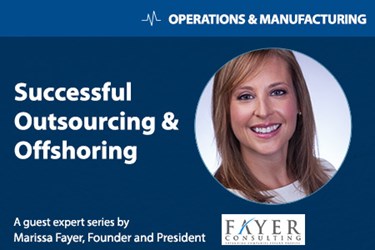Outsourcing Approaches: Large vs. Small OEMs
By Marissa Fayer, President, Fayer Consulting

Outsourcing is all the rage in today’s world. From personal grocery shoppers and drivers to company payroll and the development of your personal or business brand, outsourcing is a trend which is increasing in popularity. This is especially true among medtech OEMs, and the trend is picking up steam.
While differences between large and small OEMs are distinct and varied, these entities are even further differentiated by their approaches to and handling of outsourcing. Over the past 5 years, though, as large OEM executives have moved on to found or join smaller companies or start-up medtechs in search of new challenges and adventures, the differences have narrowed, shifting along with them outsourcing approaches and attitudes. Still, some important differences continue to persist:
Cost vs. Partnership
The large OEMs are cost-conscious and bottom-line driven, and many will make irrational decisions based on a few cents. The pressure from investors, Wall Street, and executives causes large companies to focus more on bottom-line costs and less on the overall value of its relationship with outsourcing partners. Conversely, small OEMs are looking for a partnership in which both companies can support each other and grow, receiving mutual value from the relationship. Small companies are being cost conscious, but they also see collaboration’s value as a factor in the cost equation. This is not to say that several of the large OEMs are not creating partnerships, because they are, but they often form these relationships with one-sided expectations.
Location
Location is key for both large and small OEMs. Large companies are looking for global scale either in or near their main centers of distribution, so as to minimize the movement of finished goods, which can be costly. Large companies also are looking for the labor cost reductions associated with manufacturing and assembly in lower-cost regions of the globe. Small OEMs looking for such partnerships often choose to partner with contract manufacturers (CMs) that are located geographically near to the OEM’s R&D and their corporate locations, maintaining the ease of face-to-face communication, since products often are not complete in their development cycle. This face-to-face collaboration at the point of manufacture is so vital that it oftentimes is a key factor in small companies’ CM decision.
Management Approach
Large OEMs often are very hands-off in dealing with to their contract manufacturer(s). Weekly and monthly calls between key individuals handle the flow of information, and the OEM only gets into details when there is an issue that affects the flow of products. This hands-off approach is welcome at many of the large, Tier 1 CMs, as they operate in the same manner and need to balance their volume of clients. However, in large OEM/CM relationships, money often is thrown at issues without actually resolving the root cause — treating the symptom, rather than the disease, if you will. In such cases, the root cause may not be addressed until it directly affects the flow of finished goods to the distribution points.
Small OEMs are very hands-on in managing their contract manufacturer relationships, diving into details and processes, especially upon start-up or when issues arise. For the CM, management of the client becomes a “full-time job,” as the client is interested in daily/weekly updates and likes to be in constant communication. It is the job of the CM to teach the company how the relationship should work by setting rules of engagement and driving the flow of information. The benefit of this close OEM/CM collaboration is faster resolution of issues with less financial impact on both businesses.
Business Size
Large OEMs are looking to be significant clients for their CMs, but also want to ensure that their business is strong. Specifically, large companies look to hold between a 5 percent and 15 percent share of the CM’s business and, in order to shield themselves from any CM-related issues, such OEMs only invest between 2 percent and 5 percent of their business in any one CM. This significantly changes related to small OEMs, as they embrace the partnership and the intertwined fates of each business. Thus, small companies look to comprise anywhere from 15 percent to 40 percent of their chosen CM’s business, and are willing to place anywhere from 25 percent to 100 percent of their business with a dedicated CM.
Both large and small OEMs are looking for value in their supplier and CM relationships, but that value manifests in different ways. Regardless of their size or product, all OEMs seek value in terms of cost, quality, and delivery. As the trend of consolidation and global expansion continues on the OEM side of the business, so too does the trend of seeking more intimate relationships with OEMs continue on the contract manufacturing side.
Because of the distinct needs of large and small OEMs — as well as all of the sizes in between — the contract manufacturing players and market remain quite diverse. While market consolidation has been changing the contract manufacturing landscape, there will always be OEMs with drastically different sizes and needs in this world, meaning that there is room for everyone, so long as quality is the #1 factor for all.
The next article in this series will discuss how to give back to the community in which you work, as well as the organizational benefits of this philanthropy.
About The Author
Marissa Fayer is president of Fayer Consulting, a global consulting business helping small to midsize medical device companies reduce their costs and increase their profits. The firm specializes in manufacturing relocations, project management, high performing team development, and optimization of operations. Marissa Fayer has been working in the medical device industry for over 15 years with a focus on offshore operations and project management for complex multistage integration and implementation projects. Reach her at marissa@fayerconsulting.co and on Twitter @MKFayer.
